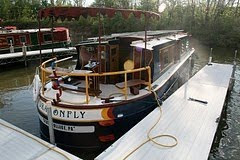As we headed back east from Buffalo, we flagged the village
of Albion as a place to stop.
The Cobblestone Museum was just
three miles north of the boat dock—easy biking distance
Cobblestone Museum . . . hmm. It’s NOT a geology museum for the fist-sized, rounded stones dropped across upstate New York by retreating glaciers.
But there ARE plenty of cobblestones here! They’re
embedded in the walls of houses—a bit of Erie Canal-centric folk architecture.
What a Curious, Cute House!
We first got interested in cobblestone houses because we
drive right past one every time we travel to our home port of Macedon, NY, to do some slowboating. The Bullis House is a fine, big Federal-style house, completed in 1842; it faces the
road to our marina.
| The Bullis House on Canadaigua Road in Macedon, right near our marina. Named for Civil War brigadier general John Bullis, who lived here with his grandparents BEFORE he went to war. |
Once we got interested in the Bullis House, we started
noticing other cobblestone houses. On our passage to Palymra earlier this summer
we spotted a townhouse-style cobblestone dwelling right near
the canal. And when we stopped for coffee and a leg-stretch in Middleport, on
our way to Buffalo, we found a cobblestone church at the center of town.
These structures are eye-catching, with their neat rows of
smoothly rounded stones embedded in mortar. They date from the 1830s to the
1860s; the cobbles convert what might otherwise be fairly plain Georgian, Federal,
or Greek Revival style houses into
something fancy.
An Erie Canal Speciality
 |
| This charming one-room school house in Orleans County was completed in 1833, used as a school till 1955! |
It turns out these handsome houses are almost (but not
quite) unique to the area around Rochester, NY. Historians who keep track of
this kind of thing have documented only about 1,000 cobblestone houses in North America. More than 900 of them are located close to the Erie Canal.
Why Cobblestones? Why Here?
We learned (at the Cobblestone Museum) that you find these
houses close to the Erie Canal for three reasons.
- One, there are plenty of cobblestones around here. This area was covered by a glacier that retreated 40,000 years ago, dropping rounded stones as it melted. Farmers turned up cobbles when they plowed their fields.
- Two, the construction of the Erie Canal between 1818 and 1825 brought lots of stone masons to the area. When the canal was complete, these masons were looking for work.
- Three, the canal brought wealth. Farmers could more easily ship produce to market and get a good price for it.
These three factors converged in an architectural trend, the
cobblestone house. Newly prosperous villagers could hire a skilled mason to build a
house (or public structure) that used readily available materials in a creative
and highly decorative way.
History Buffs to the Rescue!
 |
| Protest sign in Orleans County |
In the 1960s, a band of local residents formed the Cobblestone Society to rescue historic cobblestone structures headed for
the bulldozer. Great work, citizens!
Currently, the group is working to prevent a Dollar General store
from moving in across the street from the historic cobblestone schoolhouse pictured above.
Advocates argue that it's worth preserving the character of this neighborhood, which includes the cobblestone church, cobblestone school and several different cobblestone houses.
After all, Dollar General Stores are a dime a dozen. Cobblestone houses are rare . . . and virtual time machines. Worth preserving!







No comments:
Post a Comment